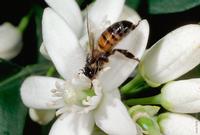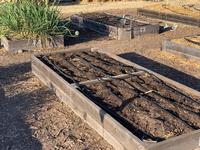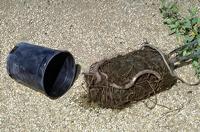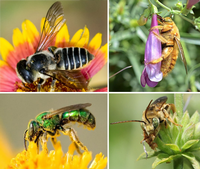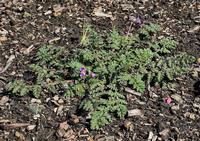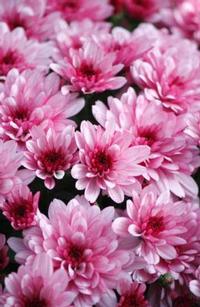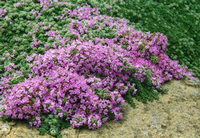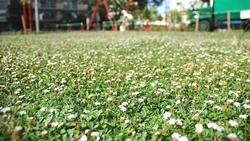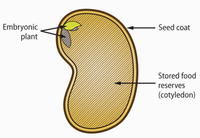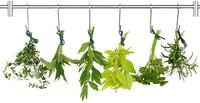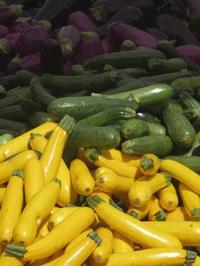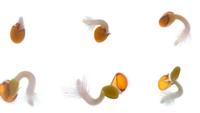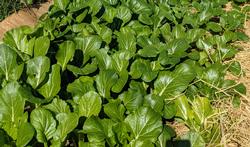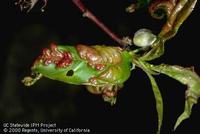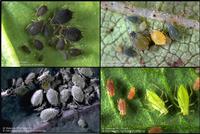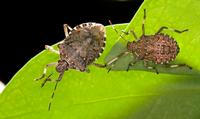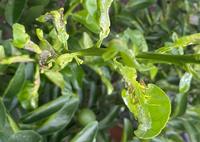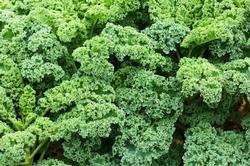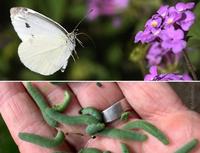Monthly Tip
1. To-do
-
Pruning Azaleas and Rhododendrons
-
Azaleas and rhododendrons can be pruned as soon as they finish flowering. This is also a good time to fertilize them. Choose an acid-forming fertilizer blended for these particular plants, and be sure to follow the label directions for amounts. Learn more by visiting the Azalea and Rhododendron society websites.
- April, May -
Citrus Fertilizing
- In California, most soils contain adequate nutrients for citrus growth, except nitrogen. Nitrogen is the primary nutrient required by the trees, and there are commercial fertilizers balanced specifically for citrus. One-year-old trees will need 1/10 of a pound of nitrogen, while mature trees need approximately 1-1/2 pounds. These amounts should be divided into two to three applications.
Blood meal without all the fillers is an excellent source of nitrogen, or you can purchase a balanced product that contains zinc. Spread the fertilizer evenly over the entire root area and water in.
For more information, refer to the UC Pest Note on Fertilizing Citrus, and Questions and Answers to Citrus Management from the UC Davis Home Orchard website.
- January, February, May, June -
Bee Swarms
-
Bees are very active in warm weather. There is simply so much pollen and nectar to collect! Sometimes, a bee colony may swarm. If you see a swarm, don’t panic. As in any other time when working around bees, remain calm, move gently, and give them their space. Bees generally swarm when they are looking for a new home. Swarming bees are loaded with food and are not interested in stinging people. Contact the Bee Guild to have swarms removed.
- May, June, July -
Deadheading
-
Deadheading means removing spent blossoms from your plants. Not all plants need deadheading, but if the flowers stay on the plant and become unattractive (think roses, dahlias, marigolds, coneflowers, geraniums and many more), then consider a little pruning. The technique varies by plant; some spent flowers can be snapped off by hand (dahlias), others are better done with hand pruners (roses), and some can be sheared off all together (lavender). You'll not only make the plant look better, you'll stimulate additional blooming for plants that have a long blooming season.
- May, June, July, August, September -
Drought Tip - Laundry to Landscape Irrigation
- A laundry to landscape system is an easy way to save water in times of drought. It can be installed easily at a low cost to send rinse water from clothes washers directly to the landscape.
Suitable plants include fruit and ornamental trees, shrubs, and ornamental annuals. It’s not applicable where the water would come in direct contact with fruits or vegetables.
More information: Laundry-to-Landscape Graywater System
- March, April, May, June, July, August, September, Any month -
Pruning Camellias
-
April and May are the best time to prune camellia. Camellia should be pruned just after flowering and before new vegetative growth gets going. If you prune later in the season, you risk damaging next years blossoms.
- April, May -
Fertilizing Ornamentals During Drought
-
One way to manage plants during drought is to reduce the amount of fertilizer used. While plants need nutrients to survive and be healthy, excess fertilizer promotes additional growth, which then demands more water.
- May, June, July, August -
Harden Seedlings
- Seedlings grown indoors or in a greenhouse are tender because they have been sheltered from direct sun and outdoor conditions. You need to acclimate them to the great outdoors, a process called hardening, before planting them into the garden. Start by giving them short exposures to full sun and cool nights, gradually increasing the amount of time. Seedlings can dry out quickly, so be sure to keep them watered, especially with hot or windy weather. Protect them if nights are cold. After about two weeks, they should be ready to start life in the garden.
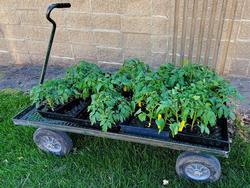
More information: Hardening Transplants
- April, May -
Watering Hydrophobic Soil
-
Just as a dry sponge repels water, overly dry soil can do the same thing. This dried out soil is called hydrophobic. Hydrophobic soil can waste a lot of water as water drains away from the plant's root zone.
In pots: learn more about how to re-wet very dry soil on our Watering Hydrophobic Soil page. In the yard: setting sprinklers to run for 5 minutes, waiting for the water to soak in, and then running for a longer time can prevent water loss due to hydrophobic soil.
- May, June, July, August -
Lady Beetle
- We all know that lady beetles are good for the garden. Make sure you can recognize the larval stage because this life stage eats even more aphids than the adult form. Lady beetles lay their distinctive yellow eggs near a food source such as aphids. The larvae grow quickly, then pupate into the familiar adult form (but there are actually many varieties of lady beetles). It’s better to attract lady beetles to your garden rather than buying and releasing them. Purchased lady beetles generally fly away, and the process of collecting them in the wild is often destructive. To attract lady beetles, refrain from spraying insecticides, grow flowers that attract beneficial insects, and leave some aphids for them to eat.
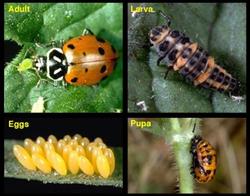 Lady beetles develop through four life stages: egg, larva, pupa, and adult by Jack Kelly Clark, UCANR
Lady beetles develop through four life stages: egg, larva, pupa, and adult by Jack Kelly Clark, UCANRFor more information: Aphid Eaters
- March, April, May, June, July, August -
Lawn Care
- As the weather changes, many of our management techniques have to change. Lawns need more water as the temperature increases and the humidity lowers. But please be sure not to overwater, too much water is being wasted by going below the root zone or running off. Adjust timers monthly throughout the year. In the warmer months, lawns may need water twice a week. It is not good to water daily. If watering is daily and brief, the roots will stay shallow and susceptible to drying and burning. Be sure to water as early in the morning as possible to avoid evaporation. This also helps reduce fungal diseases by giving the grass time to dry out during the day. Poor watering practices are the main reason for dead and dying areas in lawns and a common source of urban runoff.
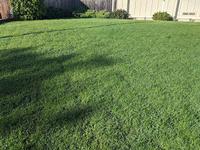
Make sure you are mowing to a height appropriate for your type of grass. Mow frequently enough so that only one-third of the leaf is removed at any one time.
Fertilizing is important, even if you are grasscycling, which only provides about 20% of a lawn's fertilizer needs. Grass is all leaf so the primary nutrient needed is nitrogen. Keep on top of weed removal.
Thatch is the layer of living and dead grass material (blades, rhizomes, stolons) that can build up on the surface of the lawn. A thin layer protects the soil surface and shallow roots from drying out from the sun, but a thick layer prevents water from getting through. You can remove dead grass material on the soil surface with a special thatch rake to allows water to reach the roots more easily.
More Information: The UC Guide to Healthy Lawns
- May, June, July, August, September, October -
Young Fruit Trees
- If you have young fruit trees, particularly ones you just planted during bare root season, you want to protect them while they’re still delicate. Water them regularly while they are establishing their root system. Put mulch around the root area to hold in moisture, moderate the soil temperature, and help keep weeds from sprouting and competing for water and nutrients. Consider painting the trunk with white latex paint, diluted 50% with water. This will reflect the sun and help prevent sunburn. Sunburn is a problem because the bark can crack, allowing pests and diseases to enter the wood more easily. Once the tree is larger and has a full canopy, the leaves will normally provide sufficient protection.
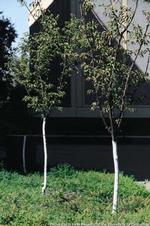
More information: Video: Getting Fruit Trees off to a Good Start (88 min)
- April, May -
Garlic Harvesting
- May–June is the time to stop watering your garlic. The tops will turn yellow and start to dry. Allow the bulbs to stay in the ground while the tops dry out, then carefully dig them up from mid-June to July. Cure the bulbs by placing them in a warm place with good air circulation, out of direct sunlight, for two weeks. Curing is an important step for good storage.
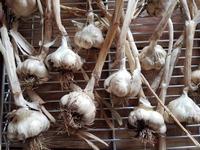
For more information: Garlic
- May, June, July -
Summer Vegetables
- Just because your summer vegetables are in the ground, beds, or containers, it doesn’t mean you can ignore them until it is time to harvest. And harvesting normally happens over weeks or months. Make sure you know what the vegetables will look like when mature; don’t be waiting for a green zebra tomato to turn red. Many vegetables are more tender when picked on the younger side. And they can go to seed and slow down production if left too long. Watering regularly is important. You need to water enough to get abundant production and make it worth the investment. Mulching and removing weeds will help conserve water for the vegetable plants. As with all plants, watch out for pests and diseases.
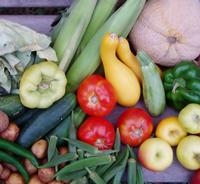
More information: Vegetable gardening
- May, June, July, August, September -
Drip Irrigation
- Consider various forms of irrigation conversion! Irrigation systems, especially drip and micro-sprinklers, have drastically improved over the last few years. For example, there are kits that convert pop-up sprinkler heads to low-flow systems. The conversion kits include a pressure regulator to control changes in pressure and a filter to improve water quality. Water usage is reduced through better water management, control of distribution and less loss from evaporation. Other advantages include :
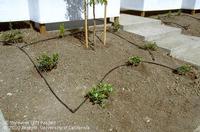 Low volume drip irrigation system
Low volume drip irrigation system- Water is placed more accurately and efficiently in the root zone, it is applied at a slow rate that reduces loss from runoff.
- Dry soil between plants allows you to work in the garden between irrigating.The key to success is watering long enough to supply adequate water to the root zone. Inappropriate watering commonly damages landscape plants. As with any irrigation system, they are efficient only when soil around the plants being irrigated is regularly monitored for proper moisture levels (Reference: UC Pest Note Poor Water Management, Poor Drainage).
- April, May, June, July, August, September, Any month -
Tomato Staking
-
It's time to start planning how you will stake your tomatoes. You will want to stake your tomatoes right after you plant your seedlings. Here are the various Tomato Staking Techniques we have tried.
- April, May, June -
Soil Management - Compost vs Mulch
-
Many home gardeners are confused about the terms “compost” and “mulch;” frequently these terms are used interchangeably, but they are not really the same thing. Here is a Comparison of Soil and Mulch from UCCE.
Amend soil with compost to create soil that will retain water but still drain well enough for roots to have the air and water they need.
Benefits of compost
- Forms aggregate particles with clay
- Creates larger pore spaces for water & air
- Helps release nutrients from clay so that plant roots can absorb them
- Supports the soil foodweb by providing nutrients for the organisms
- Lowers pH somewhat.Benefits of mulch
Mulch does not get worked into the soil. It sits on top of your irrigation system and helps:- Control weeds
- March, April, May, Any month
- Prevent erosion
- Preserve soil moisture
- Keep roots cool and moist -
Keep Foliage after Bloom Fade
- To keep bulbs/corms/rhizomes/tubers blooming each year, leave the plant’s foliage in the ground long after the blossoms have withered. That’s because the foliage needs to photosynthesize to store energy in the bulb for next year’s blooms. Deadhead the spent flowers by cutting the stalks from the finished blooms all the way back to the base, Then wait for the foliage to die back and turn yellow before removing it. Some people tie the leaves together to tidy the garden, but that’s not advised because it limits the light needed for photosynthesis. As an alternative, intersperse annuals to hide the foliage until it can be removed.
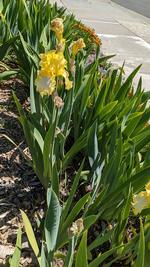
If the plants seemed crowded and the flowers were getting smaller, carefully dig them up, separate the bulbs, and replant them with greater spacing. Toss any bulbs/corms/rhizomes/tubers
that are mushy or show other signs of rot. And continue to enjoy easy-maintenance flowers year after year. More information: Basic Bulb Care
- March, April, May, June -
Container Color Choice
-
If you are growing plants in containers, keep in mind that light colors do a better job at reflecting the sun. This helps keep the soil from drying out too quickly and reduces the chances of the roots burning. If you already have dark pots, consider painting them a lighter color, or be especially careful about watering.
- April, May, June, July -
Empty Standing Water
- Make sure you don’t have any water sitting around from our late rains. Mosquitos breed in standing water and can pass along deadly West Nile Virus to people. Check and dump water from any buckets, pots, saucers, dishes, or wheelbarrows. Put containers away or turn them over to avoid collecting additional water. Keep chemicals balanced in swimming pools. Ponds, fountains, and bird baths can also be breeding grounds. Add mosquitofish to these bodies of water to eat mosquito larvae. They are an environmentally friendly means of control and are available free of charge from Santa Clara County Vector Control.
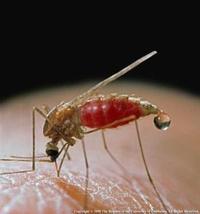
More information: Empty Standing Water Video
- March, April, May -
Should You Prep Soil for Planting?
- It’s tempting to grab a shovel and turn over all the soil in your garden as you prepare for summer planting. But should you? Increasingly, science is saying “no.” Every time you dig into the soil, you’re disturbing a very intricate, living web of organisms, bacteria, and fungi that your plants need to thrive. In contrast, a “No-Till” approach minimizes soil disturbances and keeps organic material like leaves, compost and coarsely chopped plants on the ground’s surface to slowly decompose. By keeping it moist and protected from beating sun and pounding rain, this organic material allows the soil to stay crumbly and ideal for planting.
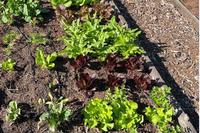
More information: No-Till for Home Gardeners
- March, April, May, October, November -
Broccoli - Multiple Harvests
- Did you know that most broccoli plants can give you multiple harvests? The first central head that they produce will be the largest and fullest. But after you harvest that one, the plant will start to produce lots of smaller heads, called side shoots. They sprout from buds in the leaf axils, where the leaves join the stem of the plant. You can keep harvesting these tender shoots, sometimes called broccolini or baby broccoli, for another 2 to 3 months.
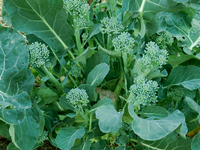
More Information: Growing Broccoli
- March, April, May, June, September, October, November, December -
Picking and preserving oranges
- By now, you may still have a lot of navel oranges on the trees. Valencia oranges are harvested through summer. For the rest, rather than leave it to rot or be eaten by rats, pick what is left soon. Even the ones that don’t fall will not stay good forever. The skin may start to ripple as the fruit inside starts to dry and suffer in quality. You can store them in the refrigerator for several weeks, but keep an eye out for mold. You can freeze orange sections for later use in orange juice or smoothies, or you can make marmalade or other orange recipes if you have already eaten enough fresh oranges. Picking the remainder allows the tree to put more energy into the current blossoms which will become next year’s fruit.
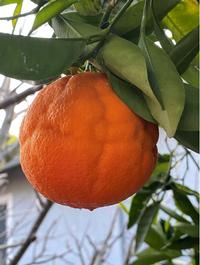 More information: Storing and Preserving Oranges- April, May
More information: Storing and Preserving Oranges- April, May -
Transplanting Vegetables
- As vegetable seedlings start to outgrow their pots, you can transplant them into larger pots, raised beds, or the ground. Make sure the seedling is well-watered before moving it. To remove the plant, either turn the pot upside down — with your other hand positioned to catch it! — or pull the entire root ball out with a fork or other utensil. Be sure never to handle the seedling by the stem, with its vascular tissue that conducts water and food. If the roots are packed together or circling, gently pull them apart. Then gently move the plant to its new home, lightly packing the soil around it. Make sure the soil is at the same level on the stem as in its original pot, except for tomatoes and peppers which can be planted deep. Immediately water thoroughly. A little fertilizer can also be added when transplanting. Transplant shock can be minimized by not changing too many conditions at once, e.g., temperature, wind, or sun exposure.
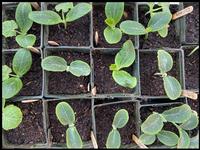 More information: Vegetable Planting Handbook (Los Angeles Master Gardeners)- February, March, April, May, June, July, August, September, October
More information: Vegetable Planting Handbook (Los Angeles Master Gardeners)- February, March, April, May, June, July, August, September, October -
Garden Planning in a Drought
- Even when we get good winter rains, our summers are dry. So, water-wise garden planning is always a smart choice. We can prioritize the plants with more value, including food production or a long-term investment. If your existing plants are crowded, consider removing some so they don’t compete for water. This is a great time to get rid of any that you don’t really like. Why waste water on them? Don’t add new plants to your landscaping while we remain in a severe drought. Even drought-tolerant plants and California natives need extra water to get established.
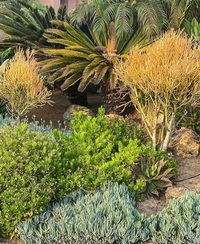
More information: Drought: Gardening Tips
- March, April, May, June -
Drought Tip - Irrigate Efficiently
- Water restrictions are being put into place all over the state due to the current drought. With over half of urban water used in landscapes, it is essential to make sure your irrigation system is efficient. Watch your plants for signs of underwatering, overwatering, or uneven watering. Consider reducing irrigation times. And make sure your water bill hasn’t unexpectedly jumped. Also, adjust systems on timers monthly as the weather changes or use an automatically-adjusting smart controller. A smart controller can make the needed adjustments after initial programming with plant, location, and other relevant information. Our Santa Clara County clay soil absorbs water slowly, so only water for a few minutes at a time to avoid runoff. Then repeat until the water penetrates to the depth of the roots. Inspect drip and sprinkler systems regularly to make sure there are no leaks, emitters are not clogged and it is watering the plants and not the sidewalk, also make sure the water is going to the root zones of the plants. If you run a hose to a plant, set a kitchen or cell phone timer so you don’t forget that the water is running. Valley Water can help residents with Water Wise Outdoor Surveys and Landscape Rebate Programs.
More information: Irrigation System Audit
- March, April, May, June, July, August, September, Any month -
Drought Tip - Lawns
- This landscaping feature—imported long ago from rainy, foggy England—does not translate well to a semi-desert with frequent droughts. Lawns demand a huge investment of water, money, time, work, equipment, and fertilizers and other chemicals. According to Scientific American, U.S. lawns require the equivalent of 200 gallons of drinking water per person per day. Many people are joining the "lose the lawn" movement, and UC Davis offers several plans and examples to help you get started on a yard design more appropriate for our climate. Valley Water offers rebates and guidance for lawn replacement. If your family uses your lawn and you want to maintain it this summer, follow the irrigation regulations of your local water company and aim for survival rather than a lush green carpet. A lawn that looks light green or brown will often be dormant (not dead) and will perk up with the winter rains; the roots can survive much longer than the blades above ground. Keep it mowed in the meantime so that weeds don’t go to seed and take over. Concrete and synthetic (plastic) turf do not benefit the environment other than not using much water.

More information: Drought Resources
- March, April, May, June, July, August, September, Any month -
Inspect Roots When Planting
- If you’re adding plants to your garden this spring, check the roots before putting them into the ground. Two things are particularly important. First, look for circling roots, which can eventually strangle the plant. Straighten them out as much as possible and consider pruning them if they’re too big to spread. Second, note where the roots start growing and plant at that depth, or slightly higher to allow for some settling. If planted too deeply, plant roots cannot get enough oxygen to grow and may suffocate and die. Planting too shallow can result in root damage from exposure and excessive drying.
More Information: Fix Those Roots Before You Plant
- February, March, April, May, September, October, November -
Water Budgeting
- We always need to use water wisely. Sometimes it is necessary to stop and think about your landscape and prioritize water use. Trees are a long-term investment, yet mature trees may have extensive root systems enabling them to find enough water on their own. Fruit trees may need watering approximately monthly during the summer in order to produce good fruit. Vegetables should always be given adequate water in order to fulfill their purpose in the garden; otherwise the little bit of water you used will have been wasted if the garden is not feeding you well. It’s helpful to understand that home-grown vegetables use much less water overall than ones purchased at the store. Established flowering shrubs, especially California natives, tend to need less water than annual flowers and maybe a more water-efficient way to have color and beauty in your garden. Lastly, keep the weeds under control so that they don’t rob water from the plants that you actually want.More Information: Water Use Classification of Landscape Species (WUCOLS)- May, June, July, August
-
Direct Seeding
- Some of the larger summer vegetables can be planted from seed directly into the garden this month. These include watermelon, cantaloupe, corn, and summer and winter squash. They tend to have larger seeds, and a rule of thumb is to plant them at a depth of two to three times the diameter of the seed. If you have a seed packet, follow instructions for planting depth, spacing, and thinning. These larger plants tend to grow quickly and out of the reach of many pests that impact small, tender, young seedlings. Amend and thoroughly water the soil before planting so that the seeds are not washed away with watering. Drop the seeds in holes and cover them with soil, or push them down into the soil. Then water again. Keep a close eye on emerging seedlings and protect them from pests as needed.More information: Planting Vegetable Seeds (Alameda County Master Gardeners)- May, June
-
Prevent Fruit Tree Sun Burn
- Summer sun can bake trunks and branches of trees, especially when pruned to allow light into the tree’s center. Use whitewash to protect the bark from sunburn and subsequent insect infestation. Coat the south/west facing sides of the trunk and the top of main, sun-exposed limbs of all young trees and on older trees pruned to allow sunlight to reach the tree interior. Use white interior latex paint diluted to half strength with water. Apply the paint mixture from the soil surface up the entire trunk (and 2 inches below the surface for newly planted trees). Smaller branches are usually naturally protected by the tree’s leaves.
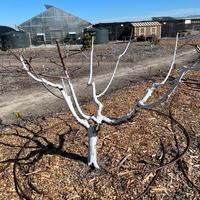 More information: Care for Young Fruit Trees- April, May, June, July
More information: Care for Young Fruit Trees- April, May, June, July -
Potting Mix vs Planting Mix
- Is there a difference between potting mix, potting soil, and planting mix? The best advice is to read the label. The terms for bagged mixes aren’t regulated, so they can vary by manufacturer. What’s important to know is that not all bagged mixes can be used in pots. Some are meant to be used as garden fill, amendment, or mulch, so they won’t provide the right water retention, drainage, or nutrients for container gardening.
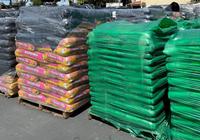
For more information: Bagged Potting Mixes
- March, April, May, November -
Irrigate in Circles and Spirals
- When you add a new plant to your landscape, it’s important to keep the root ball well watered until the roots start extending into the surrounding soil. The root ball can dry out even when the surrounding soil is moist, so an irrigation emitter is often placed right at the base of the plant. However, the irrigation needs to change as the plant matures. As the plant grows, move the irrigation away from the base and instead start irrigating in circles or spirals around it. For trees and large shrubs, continue expanding the irrigation spiral as they grow.
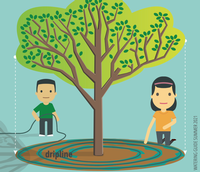
For more information: Help Your Trees Survive the Drought
- May, June, July, August -
Weed Spotlight - Spotted Spurge
- This annual weed is native to the eastern US but is now common in home gardens here in California. Spotted spurge germinates at temperatures as low as 60ºF and is often found in open areas, sidewalk cracks, and thin lawns. It forms a dense mat of foliage that grows radially from a central taproot. Left unchecked, each plant can grow to 3' across and can produce thousands of seeds. The seeds need light to germinate, so a 2" cover of mulch usually provides effective control. Pull weeds when you see them, removing the root to prevent regrowth. Use gloves to avoid contact with the white sap which can irritate skin.
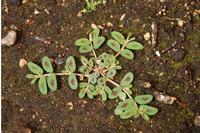 For more information: Spotted Spurge Management Guidelines- March, April, May, June, Any month
For more information: Spotted Spurge Management Guidelines- March, April, May, June, Any month -
Drought Tip - No Fertilizer
- Fertilizing your lawn and landscape encourages lush new growth. That’s usually what we want, but not during a drought. That new growth requires extra water to support it. Plus, if a plant is already drought-stressed, fertilizer may cause it more stress by stimulating growth that can’t be supported with limited water. In other cases, plants may slow or shut down growth under drought stress to conserve resources and will not use fertilizer.
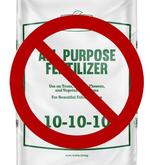
More information: Skip fertilizing
- May, June, July, August -
Protect Native Bees
- You probably see non-native honeybees in your garden, but do you know there are over 1600 species of native bees in California? These bees don’t make honey, don’t live in hives (most live right in the ground), and are much less likely to sting since they have no colonies to defend. Research shows some species pollinate crops twice as effectively as honeybees, plus they’re best suited to pollinate native plants. But like honeybees, they’re threatened by pesticides and loss of habitat. Help preserve these species by growing a variety of plants that flower at different times of the year and by keeping areas of open ground in your yard.
More information: Native Bees and Their Favorite Plants
Native Bee images, clockwise from top left: Leafcutter bee (Jim McCulloch), carpenter bee (Kathy Keatley Garvey), long-horned bee (Kathy Keatley Garvey), sweat bee (Missouri Department of Conservation Staff)
- March, April, May, June, July, August -
Pinching Flowers and Herbs
- Pinching your flowers and herbs is a way of pruning them with nothing more than your fingertips. Removing the new tender growth at the end of a stem stimulates branching, encourages more flowers, and keeps your garden blooming longer. Follow a stem tip down to the first or second leaf node (where leaves join the stem) and pinch it off just above that node. Two new stems will grow beneath the pinch, resulting in a bushier plant. Early spring—before flower buds form—is the ideal time to pinch. But not all plants should be pinched. In particular, don’t pinch flowers that produce only one flower per stem.
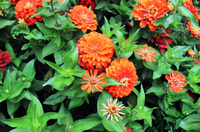 More Information: Pinching Flowers and Herbs- April, May, June, July, August
More Information: Pinching Flowers and Herbs- April, May, June, July, August -
Drought Tips - Vegetable Gardening
- Vegetables are not drought tolerant, but you can still make water-wise decisions when you grow them.
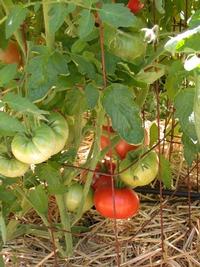
- Plant only as much as you can use. Produce that isn’t harvested wastes water.
- Plant in groups or triangular patterns rather than straight rows. This lets you water more efficiently, and the plants form a leafy canopy that shades the soil.
- Mulch, mulch, mulch to decrease moisture loss and reduce competition from weeds.
For more information: Ten Tips for Vegetable Gardening during a Drought
- May, June, July, August -
Fruit Thinning
- Fruit trees often set more fruit than they can support, resulting in small fruit and sometimes limb breakage. Peaches, plums, apricots, apples, pears, kiwifruits, and persimmons almost always need to be thinned. Thinning too late reduces the chances that remaining fruit will achieve full size. Remove excess fruit when they are about ½–1" in diameter. Apricots and plums should be thinned to 2–4" apart; peaches and nectarines to 3–5"; for apples and pears, leave one to two fruit per cluster.
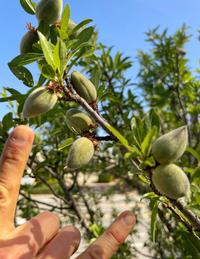 More Information: Thinning Young Fruit- April, May, June
More Information: Thinning Young Fruit- April, May, June -
Weed Spotlight - Filaree
- You may have noticed a highly prolific, rosette-shaped weed lately. Filaree (Erodium spp.) plants start out as low growing plants that can form a dense mat in open areas. They create bright pink flowers that turn into angled seed pods resembling a stork's head and beak, giving the plant one of its common names: storksbill. The spiral-shaped seeds explode out from the plant in late spring, drill into the soil with changes in humidity, and germinate with next year's rains. Recommended control methods include hoeing, hand pulling, and several inches of organic mulch.More information: Filaree- April, May, June, Any month
-
Support Your Vegetables
- Save garden space by providing good support systems for climbing or vining vegetables like tomatoes, pole beans, and cucumbers. Growing vertically also keeps plants healthier by improving air circulation, increasing sun exposure, and keeping fruits off the ground. Even shorter plants like peppers and eggplants benefit from support since heavy fruits can cause unsupported branches to break. There are many possible choices, from commercial cages and stakes to creative reuse solutions. It’s best to install the supports at planting time to avoid damaging the roots or breaking the stems of your new plants.
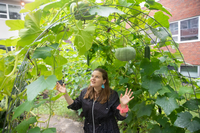
More Information: Trellising, Staking, and Caging
- February, March, April, May, June -
Mulch to Conserve Water
- A 3 to 4" layer of mulch can reduce watering needs by as much as 50 percent. Mulch reduces water evaporation and keeps soil temperatures down during hot summer months. In addition, mulch reduces the number of weeds, makes it easier to control weeds that do grow, and protects the soil from compaction. Organic mulches such as arborist chips and bark nuggets break down and improve soil quality over time. Place mulch away from the street curb to prevent heavy rains from washing it into storm drains. Also keep mulch away from the trunks of woody trees or shrubs to avoid decay problems.
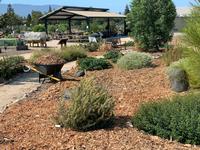
More information: Mulching with Organic Materials
- April, May, June, July, August, September, Any month -
Planting Trees or Shrubs
- You may be tempted to amend the soil when planting trees or shrubs, but it’s no longer recommended. If the soil in the hole is amended, it creates soil moisture differences that discourage the roots from growing into the native soil beyond the hole. For best results, dig a hole about twice as wide as the container. Rough up the sides to help the roots penetrate. Don’t loosen the soil in the bottom of the hole or the plant may settle too low. The goal is to keep the crown of the plant slightly above the surrounding soil. Then simply backfill with the native soil from the hole.
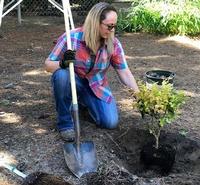
More information: Planting for Success
- March, April, May, September, October, November -
Weed Spotlight - Bindweed
- Have you seen a pretty, morning glory-like flower on a vine that winds through any plant within reach? Field bindweed is one of the most challenging weeds to control because its roots can reach depths of 20 feet or more and it readily re-grows from root fragments as short as 2 inches. The only chance of controlling this invasive weed is to stay right on top of it and remove it as soon as you see any of it peeking up out of the ground. Every time it starts growing above ground and photosynthesizing, it is storing energy in the roots. This allows it to put out new shoots. It produces many seeds which remain viable for years. Making things even worse, it’s drought tolerant. Controlling it isn’t easy, but the UC pest note below discusses options. Chemicals aren’t needed if you’re persistent in removing new growth to prevent seed production and limit the plant’s ability to store new energy in the roots.
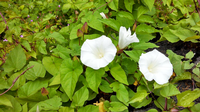
For more information: Field Bindweed Pest Notes
- March, April, May, June, July, August, September, Any month
2. What to plant
-
Chrysanthemums
- This is a less common but good time to plant chrysanthemums. They will have plenty of time to develop a good root system before the cold winter and are more likely to bloom perennially in your garden than if they are started in the fall. You can also start chrysanthemums from cuttings. Plant them in amended, well-drained soil, or grow them in a large container. Keep them moist but not wet. They do well in full sunshine, yet a little afternoon shade is fine in hot areas. If you pinch the growing tips as they grow, they will branch and be bushier. Otherwise, be prepared to provide support if they grow tall. Also, pinching off some of the buds will result in fewer yet much larger blooms. There is a Bay Area Chrysanthemum Society for local information and sharing.More Information: Chrysanthemum Disorders and Pests- April, May, June, July
-
Thyme
- Thyme is much more than an herb to season food. In ancient times it was brewed by Egyptians for mummification, bathed in by Greek soldiers for courage in battle, and used by the Sumerians as an antiseptic and antifungal. And if you want a real surprise, check out the active ingredient list on a bottle of Listerine mouthwash. In your own garden it can be used for culinary purposes or as a purely ornamental landscape feature. It grows best in well-drained soil and sunshine, although it will tolerate some shade. It is quite drought tolerant once established. Common/garden thyme (Thymus vulgaris) is an excellent all-purpose thyme, growing to a foot tall and up to two feet wide. Lemon thyme (Thymus citriodorus), with its lemon scent, makes a nice evergreen border. Creeping thyme (Thymus serpyllum) stays short and can be used as a ground cover or between stepping stones. Thyme is attractive to butterflies and bees.More Information: Growing and Using Thyme- March, April, May, June, July
-
Lawn Alternatives
- Do you have a traditional lawn? Would you like something that doesn’t need regular mowing? Something that uses less water? If you’re not ready to completely remove your lawn, walkable alternatives include California native options of red fescue and meadow sedge, as well as other alternatives like white clover, UC Verde buffalograss, Kurapia, Dymondia, and thyme.
For more information: Lawn & Lawn Alternatives
- March, April, May -
Stone Fruit Hybrids
- Plant hybridization is the crossbreeding of different plant varieties. It can happen naturally but more often comes from deliberate work. A goal of hybridization is creating a new plant with the most desirable traits of its parents, such as the sweetness of a peach and the tartness of a plum. There are many different types of stone fruit hybrids. Here are some examples:
- Pluot and aprium: hybrids of a plum and an apricot, named for which fruit dominates.
- Plumcot: a 50–50 hybrid of a plum and an apricot.
- Peacotum: a hybrid of peach, apricot, and plum.
- Nectaplum: a hybrid of a nectarine and a plum.
- Cherum: a hybrid of a cherry and a plum.
- Peacherine and pectarine: hybrids of a peach and a nectarine.
- Nectarcot: a hybrid of a nectarine and an apricot.
These hybrids have had varying degrees of commercial success, and availability may be limited. But development continues, so you may hear of others in the future.More Information: Demystifying Stone Fruit Hybrids- March, April, May, June -
Selecting Seeds
- While curled up inside the warm, dry house poring through seed catalogs, how do you decide among all the delightful descriptions? First, be clear on the purpose of your garden. Are you trying to grow exotic food? Do you want to attract native butterflies? Are you interested in flowers you can cut and bring inside? Next, think about the conditions of your site. Is it warm and sunny or is there a lot of shade? Do you have heavy clay soil? Choosing seeds that do well in your area makes for healthier plants with less work. At this point, you have the parameters within which to choose what tickles your fancy. If you would like to save seeds in the future, then choose open-pollinated seeds, including heirlooms. Heirlooms are open-pollinated seeds that have been around for multiple generations. Otherwise, you can plant hybrids that have the best traits of their parent plants but will not reproduce true to type from saved seeds. Follow planting directions on the packet for the best results.
More Information: Seed Saving- January, February, March, May, June, July, August, October
-
Attracting Bees
-
Bees are pollination workhorses, increasing garden production. Many plants will not produce fruit unless flowers are pollinated. Colorful annuals, such as Cosmos, edible African Blue Basil, and Salvias attract bees. You can also allow herbs and other plants to flower to create bee-friendly landscapes.
The University of California at Davis has a garden dedicated to bees. The Honey Bee Haven website has more resources, including a list of plants they grow.
- March, April, May, June, September, October -
Fresh Cut Flowers from Your Garden
- We have a webpage to help you choose and grow beautiful cut flowers for your home or to give away. The Cut Flower Planting Chart lists ornamentals we’ve grown successfully. We selected these for their hardiness, appeal to pollinators, and production of good cutting flowers. The chart tells you when to start these flowers from seeds or when to transplant, plus when you can expect to see blossoms.
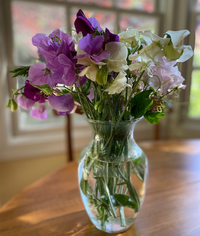
More information: Tips on planting a cut flower garden
- January, February, March, April, May, June, Any month -
Herbs
- Many herbs can be grown both indoors and out, in pots or in the ground. Rosemary grows large and needs to be in the ground or a big pot. If you use basil to make pesto, you may want a row of it in the garden. Yet most herbs tend to be used in small quantities for seasoning and so they can be grown in small containers. They can be on the kitchen counter or a windowsill for ease of use in cooking. They can be on a patio if you are in an apartment or condo. And they are well suited to container gardening outdoors. Woody herbs can be grown from cuttings, lemongrass can be started from stalks from the store, and most others can be started from seed. After harvesting, many can be dried as well as used fresh.More Information: Growing Herbs- March, April, May, September, October
-
High Yield Vegetables
- There are many considerations for choosing which edibles to plant in your garden. A particularly important one this year may be high yield. The more the plants produce, the more food you will have right on your property. Zucchini naturally comes to mind first. You may need to research additional recipes, and your neighbors may be more amenable this summer to having bags of zucchini dropped on their doorsteps during the night. Other plants that produce a lot are tomatoes and eggplant. Green beans need to be picked almost daily so they will give you an ongoing source of vegetables for a couple of months. Certain cucumbers like Persian cucumbers are eaten small and produce prolifically, enabling you to eat cucumbers more often than if you were waiting for full-size varieties. Vining plants, e.g., melons, will give you more to eat if grown on vertical supports rather than having the produce lie on the ground where it can be more readily eaten by pests.- April, May, June
-
Seed Viability
- Seed packets have a “packed for” date on the back. Yet seeds can still be viable for years beyond that date if stored correctly. Ideal storage conditions are cool and dry. The older the seeds are, the lower the germination rate will be. So plant more of the older seeds than the number of plants you ultimately want. You can do a germination test by putting seeds on a damp paper towel and enclosing them in plastic to keep them uniformly moist. Do this right before planting time so you can transplant the ones that successfully germinate. Or you can take your chances and just plant them directly and see what comes up. If you are saving your own seeds, make sure to choose seeds from the healthiest plants.
Whenever it's hard to find flower seedlings, if you have some old flower seed packets, you can scatter the seeds randomly in a section of your yard and enjoy whatever flowers.
More Information: Vegetable Seed Viability- January, February, March, April, May, August, September, October -
Camellias
- Camellias can be planted in fall through spring. Since they bloom in winter, choosing a plant now will ensure that you know the color, shape, and size of the flowers with which you will live for many years. Camellias are not native to our area so may need some extra attention in order to grow successfully. Our native clay soil does not drain well so it must be amended for camellias. Our alkaline soil needs to be acidified, and sulfur pellets are one way to achieve this. The plants need some shade and need to be kept moist. Mulch helps hold in moisture, and pine needles, redwood bark, and coffee grounds are all good organic materials that will break down over time and help improve the soil. Pick up flowers as soon as they fall to the ground to avoid the spreading of a disease called Camellia petal blight.
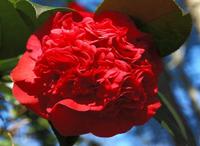
More information: Camellia Pests
- January, February, March, April, May, September, October, November, December -
Growing Peppers
-
As soon as average night time temperatures are above 55° F, peppers can be added to the garden. Before that time, they can be started indoors. Make pepper more productive by planting different varieties closely together. You will get more peppers per square foot because the plants support each other and provide protection from sunburn. Plus, they look lush and beautiful. After planting, it is a good idea to remove flowers and fruit from large-podded plants the first four to six weeks to encourage deeper roots and more foliage. Learn more pepper tips by consulting our Growing Great Peppers and Chiles page.
- May, June -
Vegetable Planting Chart
-
Wondering what vegetables can be planted now? To get the best success—whether planting from seed or transplants—refer to our Santa Clara County Vegetable Planting Chart. It's based on our own garden experiences.
- February, March, May, June, July, August, October, Any month -
Plants to Attract Butterflies
-
Butterfly populations fluctuate in response to climate and habitat conditions. Many have specific host plants on which they feed and breed. Some common plants for attracting butterflies are milkweed, lantana, buddleia, and zinnias. For an extensive list of relationships between specific butterflies and host plants, see Art Shapiro's Butterfly Site at UC Davis.
- March, April, May, June -
Asian Vegetables
- You can easily grow some vegetables used in different types of Asian cuisine and found in Asian markets. They are not necessarily native to Asia but have found their way into various cuisines. One way to decide which food to grow yourself is to choose varieties that aren't readily available or are more expensive in your local markets. It’s also fun to impress your family, friends, and neighbors with something they may not have seen growing before. Possibilities include sesame seeds, bitter melon, opo, sigua (loofah) in summer and bok choy, napa cabbage, daikon radishes, gai choy in spring or winter.- February, March, April, May, June, September, October
-
Tropical Flowers
-
If you have your heart set on tropical and subtropical plants like bougainvillea and hibiscus, planting in May will give them time to get established before the cold weather hits in the fall. Planting them in a protected area such as under eaves may keep you from having to cover them on cold nights.
- May -
Don't Plant an Invasive Plant
-
According to PlantRight, so-called invasive plants "escape into open landscapes and cause a variety of ecological problems. They displace native plants and wildlife, increase wildfire and flood danger, clog valuable waterways, degrade recreational opportunities, and destroy productive range and timberlands."
PlantRight has identified the following as invasive in Northern California: Green fountain grass (Pennisetum setaceum), Periwinkle (Vinca major), Pampas grass (Cortaderia selloana), Highway iceplant (Carpobrotus edulis), Mexican feathergrass (Stipa / Nassella tenuissima), Yellow Flag Iris (Iris pseudacrorus), Water Hyacinth (Eichhornia crassipes).
With just a little research you can avoid using plants that are unfriendly to the Bay Area.- April, May, June, July, August, September
3. Pests and Diseases
-
Peach Leaf Curl Preventive Care
- Have your peach or nectarine leaves ever looked like this? These puckered leaves are a classic springtime symptom of peach leaf curl. Severe cases can substantially reduce fruit production. Prevent this disease by applying a copper-based fungicide shortly after the leaves drop. Use a second application in late winter if there’s a lot of winter rain. Once the blossoms open and leaves appear, it’s too late to do anything. Spraying during the growing season won’t help. If you haven’t seen this on your tree, you may have a resistant variety. If so, there’s no need to spray.
More information: Pear Leaf Curl
- March, April, May -
Rose Care
- Roses are notoriously susceptible to many diseases, including rust, black spot, and powdery mildew. For this reason, they are often planted at the edges of vineyards to give an early warning about diseases that can affect the vines. Yet not everything that negatively impacts roses is a disease or pest, so don’t automatically reach for the chemicals. Abiotic disorders are caused by nonliving factors and can be addressed with cultural changes. Blackened areas on canes can be from sunburn. Brown-edged leaves may signal a high concentration of salt in the soil. Yellow leaves may be due to nutrient deficiencies. Deformed growth may be due to exposure to glyphosate, the active ingredient in Roundup. Good air circulation allows the morning dew to dry, and helps prevent rust and powdery mildew. Some practices to keep your roses healthy are to choose hardy varieties, enrich the soil with compost, fertilize regularly but not too much, irrigate directly to the root zone, and remove suckers (the rapid-growing, long canes) from roses. Prune them below the bud union.- May, June, July, August
-
Codling Moth
- If you grow apple or pear trees, you may have noticed small holes in the maturing fruit and then discovered a worm inside. "Worms" in your apples are actually the larval form of the codling moth. Codling moth larvae can cause a great deal of damage to apples, pears, plums, and walnuts by penetrating the fruit and boring into the core.
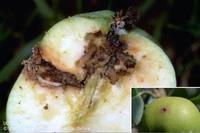 Codling moth larvae bore into the center of fruit to feed. Note the excrement, including the frass pushed out of the entry hole, Jack Kelly Clark, UC.
Codling moth larvae bore into the center of fruit to feed. Note the excrement, including the frass pushed out of the entry hole, Jack Kelly Clark, UC.Trees should be monitored every week for signs of infestation. Infested fruit should be removed and discarded to break the codling moth life cycle. Sanitation is an important non-chemical step in controlling this pest. Make sure to pick up fallen fruit promptly, and pick apples with holes that are still on the tree. This will keep future populations down.
Pheromone traps can be hung in isolated trees. But if you have just one apple tree don't bother. You will just attract codling moths to your tree.
Fruit can be bagged for protection, but this method is very labor-intensive. Heavy infestations may require the use of pesticides, but proper timing of sprays is critical. Read the UC Codling Moth Pest Note for more information.
- May, June, July, August -
Aphids
- Have you noticed that different plants attract aphids of different colors and shapes? Once you’re done admiring nature, you may want to take action to protect your plants. Aphids are classified as sucking insects, which means that they suck the juices right out of plants. They take the nutrients needed for plant growth, and the plant will start to get weak and possibly die. If you monitor your garden regularly and find aphids when their population is still small, you may be able to simply knock or hose them off the plant or prune out the infected part of the plant. When aphid populations are large, nature can help you control them — beneficial insects will be attracted to eat the aphids. You can encourage beneficial insects in your garden by including a variety of plants that flower at different times throughout the season. Avoid chemicals that kill good and bad indiscriminately. If ants are protecting the aphids in a plant, control the ants. Decide what population you will tolerate in your garden, and have patience because it can take time to establish a healthy ecosystem.
More information: Aphid management guidelines in English| Spanish
- April, May -
Earwigs
-
Earwigs are third only to snails and slugs in causing plant damage. While they are beneficial because they eat insects such as aphids, they also feed on soft plants. Earwigs can do quite a lot of damage if there is a high population. They feed at night and hide in moist, tight-fitting places during the day. Trap them by putting out moistened, tightly rolled newspaper or corrugated cardboard in the evening. In the morning dispose of the paper and the trapped insects. Other control methods are described in the UC Pest Note on Earwigs.
- May, June -
Spotted Wing Drosophila
-
Unfortunately, the Spotted Wing Drosophila is infesting local cherry, berry, and some other fruits. Look for holes in the fruit. Once the eggs hatch, maggots develop and feed inside the fruit, causing the flesh of the fruit to turn brown and soft. Dispose of infested fruit. Information on identification and control can be found in the UC Pest Note on Spotted Wing Drosophila.
- May, June -
Squirrel Control
- Squirrels are a common nuisance across Santa Clara County. They dig in pots, gnaw bark from plants, eat fruit and flower blossoms, and dig holes in yards. They are active during the day. Tree squirrels are distinguished from ground squirrels by their long bushy tails, lack of markings, and quick escapes up the nearest tree. They can be difficult to manage due to their persistence. Refer to the linked pest notes for options. A UC blog posting provides details about hunting and trapping regulations.
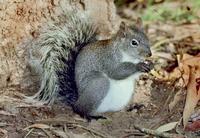
For more information: Pest Note on Tree Squirrels and Pest Note on Ground Squirrels.
- May, June, July, August, Any month -
Verticillium Wilt
-
Verticillium wilt is a soil-borne fungal disease that damages plant veins. The damage is characterized by affecting one side of the plant. The leaves may wilt and turn brown, dying upward from the base of the branch to the tip. Dead leaves often fall, but may not. Mildly affected plants may survive if fertilized and encouraged into vigorous growth. The fungus can live for years in the soil.
Planting tomatoes, peppers, eggplants, and potatoes (all members of the Solanaceae or nightshade family) in the same place no more than once every three years helps reduce the fungal population to non-harmful levels. Soil solarization may eliminate Verticillium wilt from infected soils. Crop rotation with cereals or broccolis can reduce the pathogen. Avoid high nitrogen fertilizers. Plant Verticillium wilt-resistant varieties of tomatoes, potatoes or strawberries. Refer to the UC Pest Note information on Tomato, Potato, and Strawberry for species-specific suggestions.
- May, June, July, August -
Brown Marmorated Stink Bug
- Native to Eastern Asia, this pest was introduced to the United States in the 1990s and has been established in Santa Clara County. Some features to distinguish these bugs from other stink bugs are white stripes on the antennae, a blunt head shape, and smooth shoulder margins.
They feed and reproduce on a variety of plants and are particularly damaging to fruit. You can cut cosmetic damage off fruit and still eat the rest of the fruit. To keep out stink bugs, cover vegetable plants with row covers. You can pick the bugs off plants and squish them or knock them off into soapy water. They are attracted to light and can get into homes where if vacuumed up, they can stink up your vacuum bag.
More Information: Brown Marmorated Stick Bug Pest Note- March, April, May, June, July, August, September -
Fire Blight
- This disease is so named because brown or black leaves, fruit, and branches look as if they have been burned. It is most common on apple and pear trees. Late spring and early summer are the time fire blight shows itself.
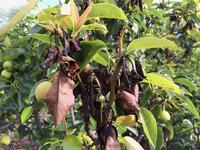
It is spread by insects, rain, or pruning. The bacteria enter through the blossoms and travel down the tree. If left unchecked, fire blight can enter the trunk and kill the entire tree. Prune infected branches back to healthy wood, at least eight inches below visible damage. If the inside of the branch is discolored, you need to cut back still further. Clean pruning tools between cuts so as not to spread the infection. A less effective way to control fire blight is to spray the open blossoms with a copper spray. Planting varieties that are less prone to fire blight is helpful. Always promptly clean up fallen fruit and leaves.
For more information, see the UC Pest Note on Fire Blight.
- April, May, June -
Carpenter Bees
-
- May, June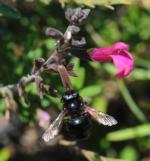 Female carpenter bees are large, black and shiny. Male carpenter bees are similar in appearance to bumble bees. Both are about an inch long. Males do not sting and females sting only rarely. Carpenter bees are considered beneficial insects because they pollinate many plants and trees. For their nests, they tunnel into unpainted softwoods such as pine, fir and redwood in house or garden structures. Adults over winter in the nests, emerge in the spring, mate, deposit food in the tunnels and lay eggs. The tunnels are sealed with wood pulp and the new adults chew their way out. After the bees emerge, fill the holes with steel wool and wood filler. Apply paint to the surface to prevent re-entry. Further information is available in the UC Pest Note on Carpenter Bees.
Female carpenter bees are large, black and shiny. Male carpenter bees are similar in appearance to bumble bees. Both are about an inch long. Males do not sting and females sting only rarely. Carpenter bees are considered beneficial insects because they pollinate many plants and trees. For their nests, they tunnel into unpainted softwoods such as pine, fir and redwood in house or garden structures. Adults over winter in the nests, emerge in the spring, mate, deposit food in the tunnels and lay eggs. The tunnels are sealed with wood pulp and the new adults chew their way out. After the bees emerge, fill the holes with steel wool and wood filler. Apply paint to the surface to prevent re-entry. Further information is available in the UC Pest Note on Carpenter Bees. -
Eugenia Psyllid
-
This psyllid has been a real problem in California. New leaves on the infected Eugenia look very much like peach leaf curl. The leaves also may become discolored. Thanks to the diligent work of the entomology researchers in biological insect control at UC Berkeley, a parasitic wasp called Tamarixia was released in Santa Clara County in 1993. The wasp is known to go as far as 45 miles and is found throughout the county. It is essential that no insecticide be used on Eugenia species. The Tamarixia wasp cannot do its job if it's poisoned. For more information see the UC Pest Note on Psyllids.
- May, June -
Fungus Gnats
- Have you ever found yourself waving away a poorly-flying, small insect near seedlings or houseplants? Or noticed a swarm of tiny flies around a composting bin? Adult fungus gnats are nuisance pests, but in high numbers, the larvae can damage roots and stunt plant growth. They thrive in moist, organically-rich potting soil and can be found indoors at any time of year. The most effective control targets the larvae by eliminating excess moisture, especially by letting the surface of container soil dry between watering. Other control methods are discussed in the linked UC Pest Note.
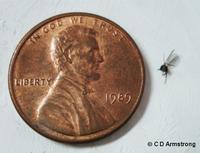
For more information: Fungus gnats Management Guide
- May, June, July, Any month -
Citrus Leafminer
- What causes young, healthy citrus leaves to become gnarled and disfigured and what can be done about it? This damage is due to the citrus leafminer moth that lays eggs on new citrus leaves. Its larvae burrow into the leaf and leave tunnels as they feed, visible as meandering serpentine mines. Our advice: don’t worry about it. Leafminers can slow the growth of young trees but even heavily damaged trees are unlikely to die. Leafminers only attack young leaves — the tough leaves of mature plants resist infestation and fruit is not affected. Damaged leaves still produce food for the tree, so don’t cut them off. If you do, it will stimulate the tree to produce more new leaves — which will attract more leafminers!
More information: Citrus Leafminer
- January, February, March, April, May, September, October, November, December -
Kale
- Kale is primarily a cool-season crop in our area but you don’t need to remove it when the weather turns warm. It will grow year-round and even for several years. The problem you are likely to see in the summer is that it gets buggy. If you can tolerate the giant whiteflies and aphids, you can leave it as a decoy plant to attract the pests away from your other plants and to feed the lady beetles so that they will stick around. Kale grows well in the ground or in containers and is not picky about the soil. If the plant gets too big and grows a tall stalk, like walking stick kale, you can cut off the top, remove the lower three or four leaves from the stalk, and stick it back in the ground and water it. It will regrow easily. You could also wait for the seeds and grow again from seed. It will probably be pest-free again and pleasantly edible when the weather turns cooler.More Information: Kale- May, June, July
-
Identifying Beneficial Insects
- A whole army of insects is in your garden ready to help your plants thrive. Pollinators, like bees and butterflies, help plants produce fruit. Lady beetles and lacewings are predators that hunt, kill, and eat insects. And parasites, like certain wasps, develop within a pest’s body and then kill them. Such violence! The trick is knowing which insects are friends or foes. To identify the insects on your own, take pictures of them and any eggs or larvae (check the undersides of leaves). Then zoom in for a closer view and use this site to help you identify beneficial insects.
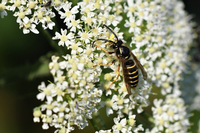
More information: Beneficial Insects
- March, April, May, June, July, August, September -
White Butterflies and Green Caterpillars
- Have you seen these small yellowish-white butterflies fluttering around? Cabbage white butterflies feed on many flowers, but for laying their eggs. They favor the cabbage family, such as broccoli, cauliflower, and mustard. The velvety green caterpillars, also called imported cabbageworms, feed on the leaves after hatching. While mature plants tolerate a few holes munched in their leaves, young seedlings don't have foliage to spare. Cultural controls include handpicking the caterpillars, brushing the eggs off the undersides of leaves, and using row covers to protect the seedlings. UC lists additional options in the link below.
More information: Managing Imported Cabbageworms
- March, April, May, June, July, August, September, October, November -
Today’s Grubs Are Tomorrow’s Beetles
- The white grubs commonly found in lawns and gardens hatch into masked chafers and green fruit beetles. Masked chafer grubs are about 1 inch long and are mostly found in lawns. They feed on roots, so a large population can cause dead patches. You may also see lawn damage from animals digging for these tasty treats. The green fruit beetle grub is much larger, about 2 inches long, and is found in compost or garden beds high in organic matter. The grubs don’t damage plants, but the iridescent beetles feed on fruits. Finding an occasional grub is no cause for worry. Just leave them out for birds to feast on.
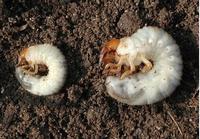 Photo credits, Left — masked chafer larva (David Cappaert), Right — green fruit beetle larva (Bugwood.org)
Photo credits, Left — masked chafer larva (David Cappaert), Right — green fruit beetle larva (Bugwood.org)More Information: What are White Grubs?
- April, May, June, July, August, September, October







